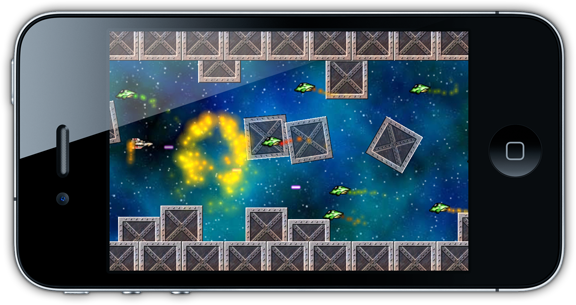Posts Tagged ‘iOS’
-
Mobile Device stats from my HTML5 Games
8th Nov 20129Given the incredible number of new devices being released at the moment I was curious to see what people playing our HTML5 games were actually using.
So I took the combined stats from 3 of our games over the past 3 months. That’s from 1st August 2012 to 31st October 2012. I discounted stats before this as I wanted a current snapshot of the state of the market. Here are the results. Update: These stats are pulled from Google Analytics, so are at the mercy of however Google handles device detection.
Total Unique Plays: 1,146,132 (3 months)
Device Breakdown

As you can see it’s a battle between Android and iOS only. The percentage of people playing HTML5 games on BlackBerry devices is actually 0.17% and on Windows Phone it’s a paltry 0.095% (!)
Having said this there are an increasing number of Windows 8 based phones entering the market right now, so it will be interesting to see how this statistic changes over the coming quarter. As for BlackBerry however that to me just looks like a lost cause.
So let’s dive into the devices a bit deeper:
-
Home Sheep Home 2 is out! Developer insights into the cross-platform build process
8th Dec 2011This has been a long time coming. Nearly a years worth of puzzle boarding, planning, animating, development, testing and packaging. But it’s finally out! Home Sheep Home 2: A Little Epic landed today across multiple platforms: Web (Flash), iOS (iPhone and iPad HD) and PC Download and is sitting happily on homesheephome2.com waiting for you to pay it a visit 🙂
The original game was something of a viral success story. Created in around12 days, primarily to promote new Shaun the Sheep episodes, it went absolutely ballistic on launch getting nearly 1 million plays per day at its peak. In 18 months it had managed 102 million plays and even today still pulls in quarter of a million players daily, with large clear peaks at the weekends.
It’s fair to say the success of the game took us a little by surprise. We knew it was good, we knew the concept was quite original, had nice cross-gender appeal and the puzzles were challenging without being frustrating. But we had no idea that so many people out there would agree! It was quite amusing at first when the clones started to appear. Somewhat less respectable companies ripped the game off and it was unofficially ported to iOS and Android.
A Chinese company even decided to steal all of the graphics and code, re-colour the sheep pink, throw in a few new levels and released it as “Home Sheep Home 2”. Somewhere around this point it was no longer funny any more and we realised it was time to invest in making a true sequel (and as a side note: In the PC version there is a cheat mode that turns all of the sheep pink, in a not so subtle middle-finger to the original rip 🙂
[ Read more for developer insight on the build process ]
-
Creation of a mobile App without the Flash IDE (for all FlashDevelop lovers)
5th Oct 2011If you read Emanuele Feronato’s blog you’ll know that the title of this post is a play on one of his. He detailed in length the process you need to go through to create an iOS App using the Flash IDE. However you don’t actually need the Flash IDE at all. If anything the process is faster and less painful using the completely free FlashDevelop.

The main reason I’m writing about this however is that with AIR3 officially released, I was keen to test the performance of Flixel code running on mobile. And I was shocked to say the least. The last time I tried creating a game for mobile using Flash was back when CS5.5 was still only in pre-release. The performance then was hideous, easily un-usable for any serious (or even semi-serious) game.
That was over a year ago, and a lot has changed. AIR3 and Flash Player 11 were officially released last night, and although they are lacking Stage3D on mobile for the time being, apparently they still bought significant speed boosts to the table. Time to put that to test with a video of results at the end.
-
App Game Kit – Write Once, Deploy Everywhere
15th Aug 2011Being able to code your game once and then deploy it to a variety of devices has been a programming holy grail for as long as I can remember. When you factor in the huge range of mobile devices on the market today, there must be a massive amount of time spent by devs porting from one platform to another. So I have been following the progress of the App Game Kit (AGK) with interest, especially as this is the very issue it claims to solve.
Created by The Game Creators, a team perhaps better known for development tools like DarkBASIC and their hit iPhone games, AGK was created to solve an internal development issue: basically they were fed-up re-coding for each new device. So AGK was born. It comes in two versions – a BASIC interpreter with game and media specific commands (like LoadImage and CreateSprite) and for seasoned developers there’s a set of C++ libraries to use. Games are automatically scaled to different screen resolutions, and issues such as input commands differing from device to device are abstracted away from you.
According to the press release AGK supports iOS, Mac OS, Windows, Samsung Bada and MeeGo from the get-go. Which means you can target App Store, Mac Store, Samsung Apps and Intel’s App Up Store. Phase 2 of the product will add Android, Windows Mobile 7, Blackberry and WebOS to the mix. I don’t have any technical details on what happens “under the hood” just yet. I.e. is the BASIC code compiled down into a native runtime, or run via some kind of vm or interpreter. I also can’t comment on actual performance once your app hits the device, but the videos TGC have posted to YouTube looked fine as do the game examples, although I admit they are very simple.
It’ll be interesting to see how this one evolves. If you make anything with it, let me know!
More info at the AGK web site: http://www.appgamekit.com/
Hire Us
All about Photon Storm and our
HTML5 game development services
Recent Posts
OurGames
Filter our Content
- ActionScript3
- Art
- Cool Links
- Demoscene
- Flash Game Dev Tips
- Game Development
- Gaming
- Geek Shopping
- HTML5
- In the Media
- Phaser
- Phaser 3
- Projects
Brain Food






